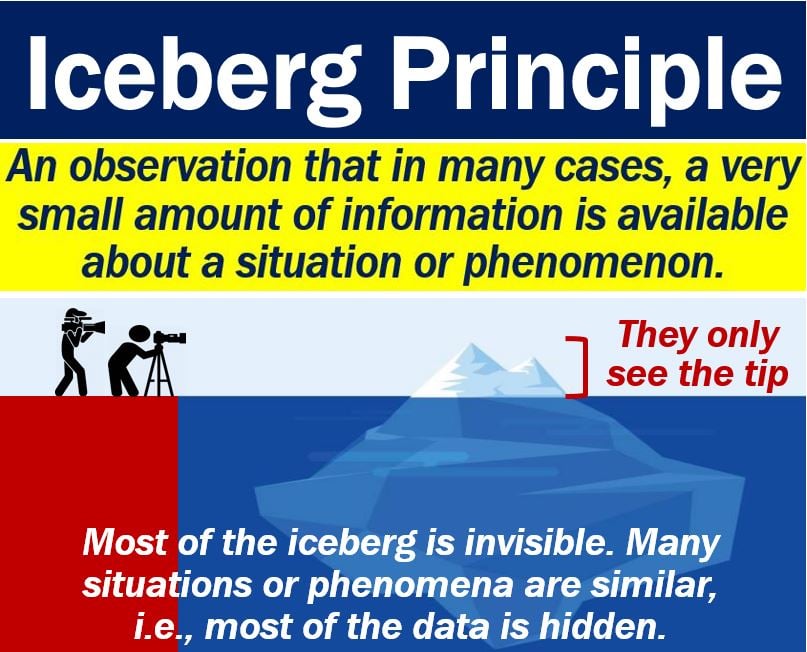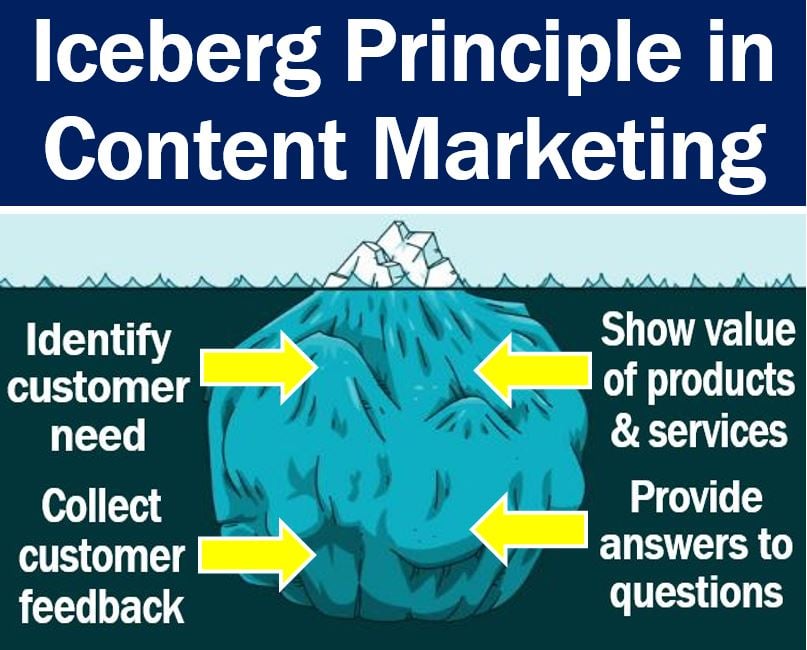Iceberg Principle – definition and example
The Iceberg Principle or Iceberg Theory is a theory that suggests that we cannot see or detect most of a situation’s data. The theory, which we also call the Theory of Omission or Iceberg Model, applies to systems and problems too. As with an iceberg, only its tip is visible, while the bulk of it is below the water’s surface, i.e., invisible.
The Titanic sank because of damage that came from below the waterline, i.e., damage the crew could not see. The Titanic was a British passenger liner that collided with an iceberg in 1912 and sank. Of the estimated 2,224 humans on board, more than 1,500 lost their lives.
Monash University in Australia has the following definition of the Iceberg Principle:
“A theory that suggests that aggregated data can hide information that is important for the proper evaluation of a situation.”
Iceberg Principle – content marketing
Content marketing focuses on creating, publishing, and distributing content for an online audience. The content marketer carefully selects the audience.
For content marketers, what is going on below the surface is just as important as what the content is saying outright.
This principle underscores the importance of looking beyond the obvious and delving deeper to discover the true essence of a matter.
In fact, what is going on underneath may be even more important. In content marketing, the Iceberg Principle is very relevant.
The Iceberg Principle encourages content marketers to invest in research and analytics, as these tools are critical in revealing the submerged part of the ‘content iceberg’ that influences audience engagement.

Therefore, while most marketers are creating more content each year, it is not enough to be simply creating content.
The marketer must create compelling content. Most of an iceberg’s bulk is below the water’s surface. Similarly, producing compelling content must demonstrate the organization’s content marketing strategy, targets, and goals.
If a firm combines all of its goals and objectives into one plan, it has a marketing strategy.
Let’s apply the Iceberg Principle to content marketing and imagine a giant iceberg floating in the ocean.
What we see above the water is what the online audience sees. However, a lot is going on below the water’s surface.
Below the surface, the marketer is trying to understand customer needs and is gathering customer feedback data (if applicable).
The marketer is also providing answers to questions and showing the value of the product or service. Look at the image below.

Iceberg Principle – Ernest Hemingway
The Iceberg Theory is also a style of writing that American writer Ernest Hemingway coined. When Hemingway wrote, he focused on surface elements, i.e., he did not discuss underlying themes.
He believed that the deeper meaning in a story should never be evident on the surface. Hemingway said that the deeper meaning should be implicit.
Some authors believe that Hemingway used that style so that he could distance himself from his characters.
Hemingway was a journalist. Journalists do not usually have time to dig deeply into a theme. Their ‘iceberg’ style sometimes prevails when they become authors of novels.
Look at the writing styles of Mark Twain, Willa Cather, Sinclair, Lewis, and Stephen Crane. They were also journalist before they started writing books.
Example sentences
Below are some example sentences containing the terms Iceberg Principle, Iceberg Theory, the Theory of Omission, and Iceberg Model, to help you see how we can use the term in context. They all have the same meaning:
Iceberg Theory:
- The Iceberg Theory in psychology posits that a person’s conscious mind is just the ‘tip of the iceberg,’ with the vast majority of their psychological contents remaining submerged in the unconscious.
- When it comes to organizational change, the Iceberg Theory suggests that the most significant and challenging elements are those that are not immediately visible, such as company culture and hidden biases.
Iceberg Principle:
- The Iceberg Principle in economics explains why only a small portion of the economic phenomenon is visible to the public while much of the underlying activity, like the base of an iceberg, goes unnoticed.
- In literature, the Iceberg Principle allows for a narrative depth that invites readers to uncover the underlying themes and messages that are not directly stated on the page.
Theory of Omission:
- Hemingway’s Theory of Omission guided his writing style, leaving much of the story’s background and context to the reader’s imagination, thereby creating a rich subtext.
- The Theory of Omission in communication implies that what is left unsaid can often hold more weight than what is spoken, reflecting the idea that silence can convey a powerful message.
Iceberg Model:
- In systems thinking, the Iceberg Model is utilized to understand the root causes of an event by distinguishing the visible events from the patterns, systemic structures, and mental models that lie beneath.
- The Iceberg Model in risk management helps analysts to identify the underlying risks that are not immediately apparent, thus ensuring a more comprehensive assessment and mitigation strategy.
Video – What is the Iceberg Principle (Theory)?
This video presentation, from our YouTube partner channel – Marketing Business Network, explains what the ‘Iceberg Theory (Principle)’ means using simple and easy-to-understand language and examples.

